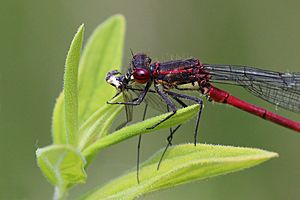Dry Sandford Pit facts for kids
| Site of Special Scientific Interest | |
 |
|
| Area of Search | Oxfordshire |
|---|---|
| Interest | Biological Geological |
| Area | 4.2 hectares (10 acres) |
| Notification | 1986 |
| Location map | Magic Map |
Dry Sandford Pit is a very special nature area located north-west of Abingdon-on-Thames in Oxfordshire, England. It covers about 4.2 hectares, which is roughly the size of ten football fields! This site is important for both its amazing wildlife and its ancient rocks.
It is officially known as a Site of Special Scientific Interest (SSSI). This means it's a protected area because of its unique plants, animals, or geological features. The Berkshire, Buckinghamshire and Oxfordshire Wildlife Trust helps to manage and protect this wonderful place.
Contents
What Makes Dry Sandford Pit Special?
Dry Sandford Pit is unique because it shows us what the Earth was like millions of years ago. It used to be a sand quarry, a place where sand was dug out of the ground. When they dug, they uncovered layers of rock that tell an incredible story.
A Peek into the Jurassic Period
The rocks you can see at Dry Sandford Pit were formed during the Jurassic period, about 160 million years ago! This was a time when dinosaurs roamed the Earth. These rocks are made of limestone, which formed in shallow coastal waters. Imagine a warm, shallow sea covering this area long, long ago.
Discovering Ancient Fossils
If you look closely at the rocks, you might find fossils! Many ammonites have been found here. Ammonites were sea creatures with spiral shells, a bit like snails, but they lived in the ocean during the time of the dinosaurs. Finding these fossils helps scientists understand what life was like in the Jurassic sea.
Home to Diverse Habitats
Dry Sandford Pit is also a fantastic place for nature because it has many different types of environments, called habitats. These habitats are rich in calcium carbonate, which is a mineral found in limestone.
Exploring the Different Habitats
- Fen: This is a type of wetland with special plants that like wet, chalky soil.
- Grassland: Open grassy areas where many insects and small animals live.
- Scrub: Areas with bushes and small trees, providing shelter for birds and other creatures.
- Heath: This habitat has low-growing plants like heather, which thrive in sandy, acidic soils.
A Haven for Insects
This site is incredibly important for insects, especially bees and wasps. Scientists call this "nationally important entomologically," which means it's one of the best places in the country for studying and protecting insects. The different habitats provide food and homes for many types of bees and wasps, which are vital for pollinating plants.
Protecting Our Natural Heritage
Dry Sandford Pit is not just a cool place to visit; it's also a Geological Conservation Review site. This means it's recognized as one of the most important geological sites in Great Britain. Protecting places like Dry Sandford Pit helps us learn about Earth's history and makes sure that future generations can enjoy and study these amazing natural wonders.

